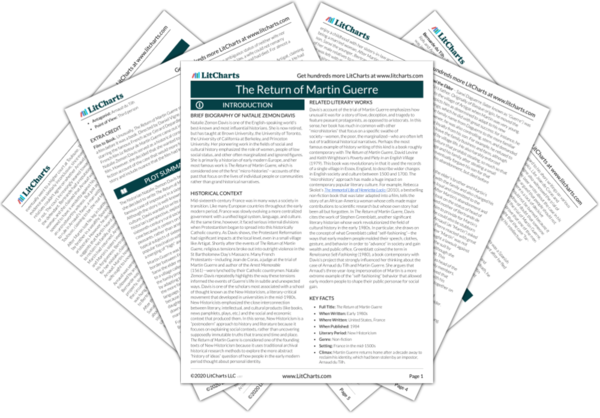Identity and Property
In The Return of Martin Guerre, historian Natalie Zemon Davis analyzes a sixteenth-century case of mistaken identity in which Martin Guerre abandons his family and property, and another man impersonates him to take over his life. In sixteenth-century France, rural peasants had few markers of identity. There were no photographs, birth certificates, or background checks. Instead, people’s identity was synonymous with what they owned: the land they inherited, the goods they sold at the…
read analysis of Identity and PropertyNarrative and Authority
As a historical narrative of an event many centuries in the past, The Return of Martin Guerre is naturally concerned with questions of narrative and authority. How are stories told? Who has the right to tell them? Davis reflects on these issues both as a modern historian and in her description of the sixteenth-century narratives that first told the remarkable story of Martin Guerre’s disappearance and the takeover of his life by another man…
read analysis of Narrative and AuthorityWomen, Honor, and Power
In sixteenth-century French rural society, a woman’s worth in the eyes of society was closely aligned with her “honor”—defined as morality, sexual chastity, and respectability. This concept was so important to both society’s perception of women and women’s own self-conception in this historical period that Davis devotes an entire chapter to “The Honor of Bertrande de Rols.” Since women had few avenues for exerting power in this period, the preservation of their honor was…
read analysis of Women, Honor, and Power
The Nature of Evidence
The Return of Martin Guerre is partly an account of a famous trial, and the book is deeply concerned with problems of evidence. The case of Martin Guerre was so difficult to solve because it was not at all clear how the court should go about assessing the evidence for identity theft in 16th century France. How could it be proved beyond a shadow of a doubt that Arnaud du Tilh was or was not…
read analysis of The Nature of Evidence






